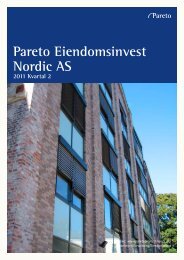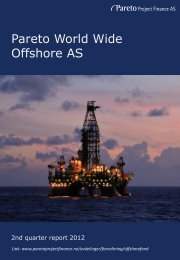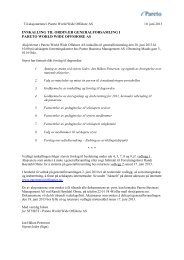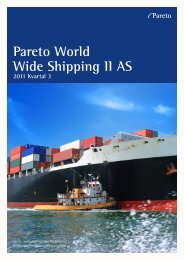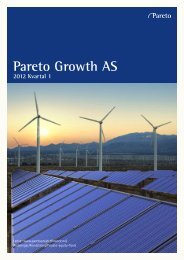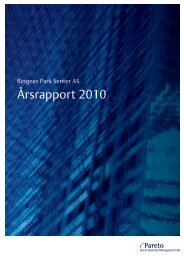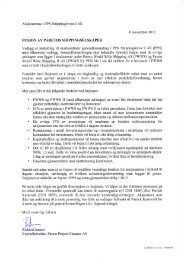Pareto World Wide Offshore AS - Pareto Project Finance
Pareto World Wide Offshore AS - Pareto Project Finance
Pareto World Wide Offshore AS - Pareto Project Finance
Create successful ePaper yourself
Turn your PDF publications into a flip-book with our unique Google optimized e-Paper software.
Executive SummaryNAV NOK 118/share(as of 30.06.2012)The offshore oil services markets continue to tighten and the outlook for the oil industry’s upstream spending in thecoming years is very encouraging. Owners of modern high quality assets look well placed to reap solid returns, bothin the form of increasing earnings and appreciating values. While the current weak financial markets depress assetvalues a bit, the bonus is that it will also restrict speculative newbuilding, thus improving future utilisation levels.Market Development<strong>Offshore</strong> oil service activity levels have risen significantly inthe past year. As a result, utilization levels have improved,leading to significantly improved rate levels. As evidencedby the mushrooming order backlogs amongst oil servicecompanies, the volume of work in the coming years seemsto be very solid. This is also leading to more long termcontract opportunities, which is a bonus with regards tofinancing.On the other hand, both stock markets and oil prices havebeen volatile. While the current levels reflect a certaindegree of optimism, things will continue to be sensitive todevelopments in the European debt crisis as well aseconomic data coming out of China and a solution to theIranian stand-off.Bank financing has become much more restricted and thelack of funding is restricting asset transactions anddepressing asset values. On the positive side, it also limitsthe scope for speculative newbuilding, which ultimately willbe positive for the future asset utilization levels.In the coming years, we expect oil industry spending growthto stay in excess of 10% per annum. This will be primarilydriven by efforts to stem the declining production fromexisting reserves. Demand growth for oil & gas will be asignificantly less important driver.New reserves are more costly and difficult to develop,requiring more oil service input, which takes more time toprovide. As a result, the main problem for the oil industry isactually turning new reserves into production, as evidencedby the disappointing production growth figures seen amongoil companies and main producing regions alike. The oilindustry is facing an uphill battle and will be forced tocontinue to hike spending to keep pace. And increasingcosts will raise the price of the marginal barrel, providingsupport for global oil prices.PortfolioFollowing a successful turnaround of its portfolio during2011, PWWO retains a high contract coverage, whichcurrently stands at 92% with an average contract length of4.6 years. The bulk of the backlog is against solid andprofitable counterparts.The portfolio is focused on modern assets and is well spreadacross several market segments and geographic regions.The high contract coverage is expected to result in a solidincrease in incoming cash flow, which in turn will take downasset exposure and pave the way for increasing pay-outs toshareholders.There has been one significant negative development,however. Songa <strong>Offshore</strong> has signed a Heads of Agreementto sell the Sonca Eclipse to Seadrill. This would in principletrigger a bonus payment to PWWO on top of the proceedsthat were received upon the sale of PWWO’s 13% stake toSonga in Q2’11. This bonus payment is dependent on theprice of the rig, as well as the level of net interest bearingdebt in the project. No price has been disclosed, butspeculation is that it is well below the price Songa paidPWWO last year. Moreover, the significant operationalheadwinds have resulted in a substantial cash drain in theproject since the rig was delivered, meaning that the level ofdebt attached the rig is way above plan. Therefore, a bonuspayment appears very unlikely. This will have a negativeimpact on PWWO NAV of around NOK 9 per share, but willhave no effect on the existing cash reserves in PWWO.In agreeing to the bonus scheme, PWWO placed a bet thatultra deepwater markets would improve going forward. Thiswas spot on, but we were stuck on the wrong horse. Thegood thing is that we got out before things really turnedbad.The way forwardPWWO has paid NOK 22 per share to its shareholders duringthe past two years. In general, the contract backlog willsupport roughly a similar level going forward, with assetsales proceeds providing an upside potential. On the otherhand, the loss of the potential proceeds from the SongaEclipse bonus payment will have a negative effect on thedividend capacity.The board strives to maximize values for its shareholdersand believes that project realizations should be done later,rather than sooner. This is to reap rising asset values, aswell as to exploit the rapid deleveraging in the underlyingprojects. With reference to our discussion about the marketdevelopment on this page, it is definitely not a seller’smarket out there and asset owners will be well advised tohave patience to maximize exit values.The board is conscious that the current financial distressseen in many markets will provide interesting investmentopportunities, some of which we have already looked at. Adiscounted investment in a good market could provide extrareturn potential for shareholders.The strategy towards 2014 will therefore be to build on thecurrent, solid portfolio, with a view to make a full exit atthat time. This is considered a better alternative than aforced run-off in an early market recovery phase. However,the current state of the financial markets indicate that thismay take longer than earlier anticipated.



